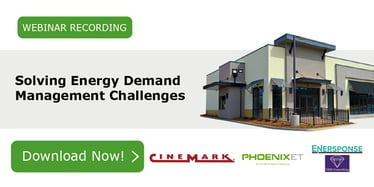Share this
Maximizing Demand Response Programs in 2023 - How Retailers Can Plan Now
by Phoenix Energy Technologies on Dec 15, 2022

Energy use is a major operational expense, and the management of it is one of retail’s biggest focus areas for sustainability. With the industry consuming billions of dollars of energy per year, the opportunity for savings is immense – along with the important environmental benefit of dramatically reducing greenhouse gas emissions.
While the focus of the holiday season is on sales and profitability, the season is also the perfect time to plan so that you can personally impact your organization’s bottom line through earning financial incentives on energy savings with Demand Response (DR).
Demand response refers to the practice of reducing or shifting electricity consumption during periods of high electricity demand in order to avoid overloading the electric grid and prevent blackouts. Demand response is important because it helps balance supply and demand of electricity on the grid, and can prevent blackouts, the need to “fire up” gas-peaking power plants, and avoid costly upgrades to the grid which are usually passed onto rate-payers. By reducing or shifting electricity use during periods of high demand, demand response can help prevent overloading the grid and ensure that there is enough electricity to meet the needs of all customers.
In addition to improving the reliability of the electricity grid, demand response can also help reduce greenhouse gas emissions by promoting the use of cleaner, more efficient forms of electricity generation (avoiding those gas-peakers). By reducing the need for utilities to rely on fossil fuels to meet peak demand, demand response can help to reduce the overall carbon footprint of the electricity system.
Demand management (or what we call “persistent demand management”) is a strategy that goes hand-in-hand with demand response as it aims to balance the supply and demand of electricity on the grid. Unlike demand response, which requires buildings to curtail their consumption when a utility sends a signal, persistent demand management requires a building to continuously balance its energy demand to avoid large demand spikes – it’s an application that runs 24 x 7 and in parallel with demand response programs. The importance of demand response and demand management lies in their ability to help maintain a stable and reliable electricity grid. By managing demand, these strategies can help prevent blackouts and other disruptions, and can also help utilities avoid the need to build expensive new power plants or transmission lines to meet peak demand. In addition, demand response and demand management can help reduce greenhouse gas emissions by promoting the use of cleaner, more efficient forms of electricity generation. Finally, both techniques can significantly reduce retailers’ energy expense with little investment and opportunity cost.
There are a few key factors to consider when deciding which demand response programs will provide the maximum financial benefit. Some of the key factors to consider include:
- The specific needs of the grid operator and the local electricity market: Different regions and electricity markets have different needs and challenges, so the type of demand response program that works best in one area may not be the most effective in another. Program requirements like notification window and curtailment duration can vary significantly.
- Building types can have differing ability to participate in demand response: Different types of buildings have different levels of flexibility and ability to participate in demand response programs. For example, large industrial customers may have more flexibility to shift their electricity use than residential customers and retail is often in between these extremes.
- The type of technologies and resources available: The availability of different technologies and resources can affect the feasibility and cost-effectiveness of different demand response programs. For example, some programs may require customers to have access to advanced metering infrastructure, while others may be more suitable for customers with on-site generation or storage.
- The potential for financial incentives: Different demand response programs may offer different levels of financial incentives including rebates that can apply demand response modernization investments.
A recent, informal poll of our customers indicates that multi-site businesses like retailers and grocery chains, on average, only participate in about 20% of the demand response programs available. That's A LOT of money left on the table, but why? Here are the four most common challenges we hear:
- It requires too much time to quantify and evaluate multiple demand response programs.
- They don’t have the staff to deal with the complexity of managing hundreds or thousands of sites with multiple different building automation systems across a portfolio.
- It’s unclear what demand response aggregators (or curtailment service providers) offer the best pricing and market access based on their broad geographic footprint.
- They are unsure if the effort or potential risk to occupant comfort is worth the financial gain.
Phoenix Energy Technologies developed Demand Manager™ to solve all of these technical roadblocks and our team can help you easily identify, quantify, and qualify the value of all DR programs across your portfolio.
And with more than a decade of experience, Phoenix Energy leverages partnerships with leading DR aggregators to significantly streamline and simplify the contracting process and bring energy-reducing activities to customers’ store nationwide. Join us for our live webinars coming up in January, February, and March 2023 where you can hear directly from our Demand Response partners.
Demand Response program contracting begins February 1, so timing is perfect to get your planning and process started now.
Additional Resources
- 4 Common Myths of Energy Conservation in Building Management
- Adaptive Energy Management Guide
- Building Management Technologies Guide
- Are You Managing Your Energy Spend?
Share this
- Facilities Management (91)
- Energy Management (69)
- Company News (49)
- Smart Buildings (37)
- Retail (36)
- Building Management (24)
- Building Automation Systems (21)
- Sustainability (20)
- Energy Demand Management (19)
- EEI (15)
- Adaptive Energy Management (14)
- Grocery (14)
- demand response (14)
- Artificial Intelligence (12)
- Data Integration and Visibility (10)
- HVAC IQ (9)
- COVID-19 (8)
- Customer Spotlight (8)
- Carbon Management (7)
- Setpoints and Temperatures (7)
- Equipment Maintenance (6)
- Operational Efficiency (6)
- Refrigeration Optimization (6)
- Ask Ron (5)
- Asset Manager (5)
- Finance and Procurement (5)
- IoT and Digital Transformation (5)
- Awards (4)
- Comfort (4)
- Energy & Store Development (4)
- Safety and Compliance (4)
- Demand Charge Management (3)
- Energy Management System (3)
- Lifecycle Asset Management (3)
- Premium Services (3)
- Refrigeration IQ (3)
- Automated Demand Response (2)
- ConnexFM (2)
- Customer Service (2)
- HVAC Vendor Management (2)
- Load Shedding (2)
- Technician View (2)
- AIM Act (1)
- ALD (1)
- Analytics (1)
- Data (1)
- Data Integration and Visualization (1)
- EMS (1)
- Knowledge Center (1)
- OSHA (1)
- asset management (1)
- December 2025 (1)
- November 2025 (1)
- October 2025 (2)
- September 2025 (1)
- August 2025 (3)
- July 2025 (1)
- June 2025 (1)
- May 2025 (2)
- March 2025 (2)
- February 2025 (1)
- January 2025 (2)
- December 2024 (2)
- October 2024 (1)
- September 2024 (1)
- August 2024 (2)
- June 2024 (2)
- April 2024 (2)
- March 2024 (2)
- January 2024 (1)
- December 2023 (1)
- October 2023 (2)
- September 2023 (2)
- August 2023 (2)
- July 2023 (1)
- May 2023 (2)
- April 2023 (2)
- March 2023 (3)
- February 2023 (1)
- January 2023 (1)
- December 2022 (1)
- November 2022 (2)
- October 2022 (2)
- September 2022 (1)
- May 2022 (2)
- April 2022 (1)
- March 2022 (3)
- February 2022 (2)
- January 2022 (4)
- December 2021 (2)
- November 2021 (3)
- October 2021 (1)
- September 2021 (3)
- August 2021 (4)
- July 2021 (1)
- June 2021 (2)
- May 2021 (1)
- January 2021 (2)
- December 2020 (2)
- November 2020 (2)
- October 2020 (3)
- September 2020 (4)
- August 2020 (3)
- July 2020 (2)
- June 2020 (3)
- May 2020 (3)
- April 2020 (5)
- March 2020 (5)
- February 2020 (4)
- January 2020 (4)
- December 2019 (4)
- November 2019 (3)
- October 2019 (4)
- September 2019 (5)
- August 2019 (4)
- July 2019 (4)
- May 2019 (2)
- April 2019 (3)
- February 2019 (1)
- December 2018 (1)
- November 2018 (1)
- October 2018 (3)
- September 2018 (3)
- August 2018 (3)
- July 2018 (3)
- June 2018 (3)
- May 2018 (1)
- June 2015 (1)
- March 2013 (1)
- January 2013 (1)
- December 2011 (1)
- October 2011 (1)
- September 2011 (1)



